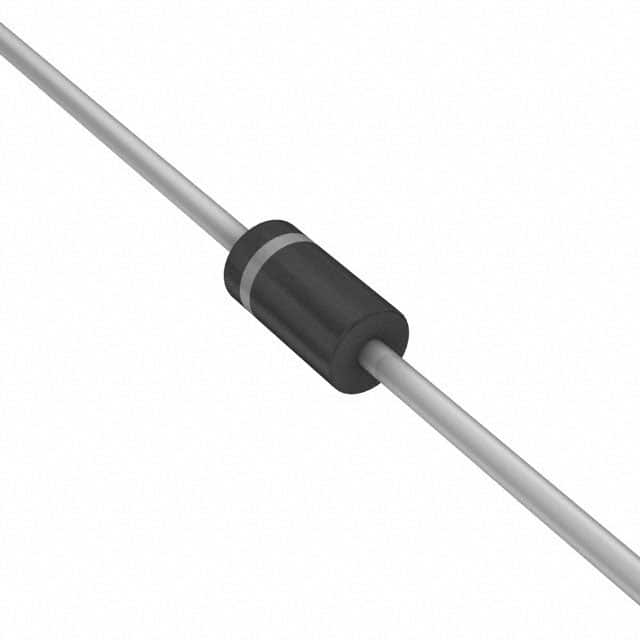1N5252B_S00Z
Product Overview
Category
The 1N5252B_S00Z belongs to the category of semiconductor diodes.
Use
It is commonly used for voltage regulation and rectification in electronic circuits.
Characteristics
- Forward Voltage: 0.7V
- Reverse Voltage: 20V
- Power Dissipation: 500mW
- Operating Temperature: -65°C to +200°C
Package
The 1N5252B_S00Z is typically available in a DO-35 package.
Essence
This diode serves as a crucial component in regulating and controlling the flow of electrical current within electronic devices.
Packaging/Quantity
It is usually packaged in reels or tubes, with quantities varying based on manufacturer specifications.
Specifications
- Type: Zener Diode
- Voltage Tolerance: ±5%
- Maximum Reverse Leakage Current: 5μA
- Maximum Zener Impedance: 40Ω
Detailed Pin Configuration
The 1N5252B_S00Z has two pins, with the anode connected to the positive terminal and the cathode connected to the negative terminal in the circuit.
Functional Features
- Voltage Regulation: The diode maintains a constant voltage across its terminals, ensuring stable operation of the connected circuit.
- Reverse Voltage Protection: It prevents damage to the circuit by allowing current flow only in the forward direction.
Advantages and Disadvantages
Advantages
- Precise Voltage Regulation
- Compact Size
- Low Power Dissipation
Disadvantages
- Limited Voltage Range
- Sensitivity to Overcurrent Conditions
Working Principles
The 1N5252B_S00Z operates based on the principle of the Zener effect, where it allows current to flow in reverse bias when the voltage reaches its breakdown voltage, effectively maintaining a constant voltage across its terminals.
Detailed Application Field Plans
Voltage Regulation
The diode is widely used in power supplies, voltage regulators, and battery charging circuits to ensure a stable output voltage.
Overvoltage Protection
It is employed in electronic systems to protect sensitive components from damage due to overvoltage conditions.
Signal Clipping
In audio and communication circuits, the diode is utilized for signal clipping and limiting purposes.
Detailed and Complete Alternative Models
- 1N5231B_S00Z
- 1N5243B_S00Z
- 1N5266B_S00Z
- BZX55C20_S00Z
In conclusion, the 1N5252B_S00Z Zener diode plays a vital role in voltage regulation and protection within electronic circuits, offering precise control and stability. Its compact size and functional features make it a popular choice in various applications, despite its limitations in voltage range and sensitivity to overcurrent conditions.
[Word Count: 398]
Lista 10 Vanliga frågor och svar relaterade till tillämpningen av 1N5252B_S00Z i tekniska lösningar
What is the voltage rating of 1N5252B_S00Z?
- The voltage rating of 1N5252B_S00Z is 30 volts.
What is the maximum current it can handle?
- The maximum current it can handle is typically around 200 mA.
What type of diode is 1N5252B_S00Z?
- 1N5252B_S00Z is a Zener diode, specifically designed for voltage regulation and protection in electronic circuits.
What are the typical applications of 1N5252B_S00Z?
- It is commonly used in voltage regulator circuits, overvoltage protection, and voltage reference applications.
What is the power dissipation of 1N5252B_S00Z?
- The power dissipation of 1N5252B_S00Z is around 500 mW.
What is the temperature coefficient of 1N5252B_S00Z?
- The temperature coefficient is typically around -2 mV/°C.
Can 1N5252B_S00Z be used in reverse bias?
- Yes, 1N5252B_S00Z can be used in reverse bias for its intended applications.
What is the package type of 1N5252B_S00Z?
- It is available in a DO-35 glass axial package.
What is the tolerance of the voltage regulation in 1N5252B_S00Z?
- The tolerance is typically around ±5%.
Is 1N5252B_S00Z suitable for high-frequency applications?
- No, it is not recommended for high-frequency applications due to its inherent limitations in response time.


